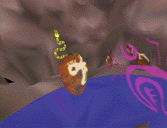

 |
Where and how could voices be stored and re-played? We designed the Voiceholders to be virtual record/playback devices. A Voiceholder would capture and store an utterance, called a Voicemark. A "full" Voiceholder (that is, one containing a Voicemark) would play its contents when touched. In order to encourage people to play with relationships among Voicemarks and between Voicemarks and landscape features, we made the Voiceholders moveable, exempt from gravity, and able to be placed anywhere one could reach. We wanted people to think of the Voiceholders more as tools or agents than as devices; machines (including tape recorders) were inconsistent with the fantasy context. We designed them as rocks with faces, using the facial expressions to indicate the state of the Voiceholder (look here to see the designs we evolved for Voicemarks). The first time a participant activated a Voiceholder it would say in a deep quiet male voice "I'm listening" (subsequent activations of Voiceholders would be silent). This was as close as we came to an iconic or symbolic interface element.
We saved all of the audio recorded by
participants in the voiceholders - and it is
here on this archive.